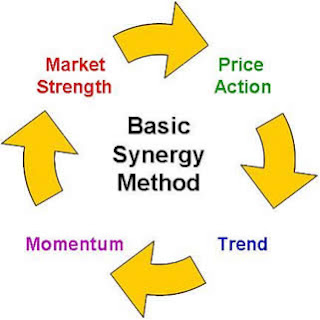SYNERGY Method
Why the SYNERGY Method?
The “ trading edge ” of Synergy:
1. A high degree of probability.
2. Enter and exit trades with less emotions.
3. Trade decisions dictated by price action, not
by preconceived beliefs and opinions.
Why the SYNERGY Method?
The “ trading edge ” of Synergy:
1. A high degree of probability.
2. Enter and exit trades with less emotions.
3. Trade decisions dictated by price action, not
by preconceived beliefs and opinions.
 There are 4 primary market conditions in a potential trade:
There are 4 primary market conditions in a potential trade:
- Price Action (PA)
- Trend
- Momentum
- Strength
- Average Price Bars
- Price Action Channel
- Traders Dynamic Index

Average Price Bars
- Provide a better depiction of current market.
- Reveal market strength & consolidation.
- Eliminate fluctuations of nominal price action.
- Remove the noise of price distortion of the
underlying trend.
Heiken = “Average”
Ashi = “Bar”
Heiken Ashi averaging technique:
– HA_Close = (Open + High + Low + Close) / 4
– HA_Open = (haOpen(previous bar) +
haClose(previous bar))/2
– HA_High = Maximum(High, haOpen)
– HA_Low = Minimum(Low,haOpen)
The HA_Close is most important for the SYNERGY Method.
Typical Candlesticks






Price Action Channel
Traditional Price Channel
Traditional Price Channel has two formats:
1. A pair of trend lines above and below price
like the Linear Regression Channel.
2. An envelope of bands around price with set
deviation limits such as Keltner Channel.
Used to determine upper and lower boundaries and signal potential reversals or breakouts.
Traditional price channels can cause “reactive” trading.
Sets inside of price movement…instead of
outside of price waiting for the market.
Used by institutional traders and sophisticated trading programs.
Promotes “responsive” trading!
Use Smoothed Moving Average
Top of Channel = 5 period, High
Bottom of Channel = 5 period, Low
- Provides overall trend direction.
- Reveals periods of consolidation.
- Used primarily as an Entry target.
- BUY Trend – Average Price Bars tend to run
on top of channel. - SELL Trend – Average Price Bars tend to run
on bottom of channel.

Good SELL (Short) Trend

Range - Bound, No Trend

Traders Dynamic Index
A hybrid indicator developed to
indicate market conditions related to
trend direction , momentum , and
market volatility .
An “all-in-one” indicator!
Step 1: RSI Price (Green) Line
 Rules: Trade Long when Green line > 50.
Rules: Trade Long when Green line > 50.
Trade Short when Green line < 50.
Consider exit when Green line is > 68 or < 32.
RSI Price Line compared to Price Action

Step 2: Trade Signal (Red) Line
 Rules: Trade Long when Green > Red
Rules: Trade Long when Green > Red
Trade Short when Green < Red
Exit trade when Green & Red crossover
Step 3: Market Base (Yellow) Line
 Rules: Market Base Line (MBL) is the Overall Trend
Rules: Market Base Line (MBL) is the Overall Trend
Trade Long when Green is > Yellow line
Trade Short when Green is < style="font-size:130%;">Market Base Line compared to Price Action

Market Base Line forecasts Market Reversals

Step 4: Volatility Band (Blue) Lines

Rules: Possible to add to a Long when Green is > VB
Possible to add to a Short when Green is < VB
Consider exit when Green crosses back over VB
Volatility Bands compared to Daily Price Action
 Volatility Bands compared to Intraday Price Action
Volatility Bands compared to Intraday Price Action
 SYNERGY Method
SYNERGY Method
Entry Rules
Average Price Bars (APB)
- Look for Positive or Negative bars trending.
- Monitor the current haClose
- Long entry = haClose > PAC High Moving Average
- Short entry = haClose <>
- Monitor the direction of the Channel
- Monitor the High & Low Channel values in relation
to the current haClose - Long entry = haClose > PAC High & PAC uptrend
- Short entry = haClose <>
- Long entry = RSI PL > 50, TSL, and MBL.
- Consider adding to Long if RSI PL > the
upper Volatility Band, > 50, and > 68.
Entry Setups
Long Entry : (All conditions are satisfied.)
1. APB haClose > PAC High Moving Average.
2. PAC trending up.
3. TDI = RSI PL > 50, TSL , and MBL .
Short Entry : (All conditions are satisfied.)
1. APB haClose <>
2. PAC trending down.
3. TDI = RSI PL <>
Exit Rules
- APB Long exit
changes to a negative bar at close.
- PAC Long exit
- TDI Long exit
2. Green > 68
3. Green crosses back below the upper Volatility Band to the upside.
- APB Short exit
changes to a positive bar at close.
- PAC Short exit
- TDI Short exit
2. Green <32>
3.Green crosses back up over the lower Volatility Band

















1 comments:
I can't download your indicator. includeP:
Chaikin's Volatility_Kalenzo.mq4
HeikenAshi_DM.mq4
mtf_synergy_indicators.zip
synergy.tpl
SynergyInd.mq4
Traders_Dynamic_Index.mq4. PLEASE HELP ME!
Post a Comment